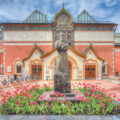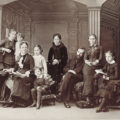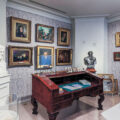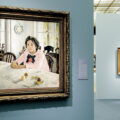- Семья Третьяковых, 1884 год / Tretyakov family, 1884
- Экспозиция «Кабинет П .М .Третьякова» / Exposition of Tretyakov’s Office
- Современная экспозиция Третьяковской галереи / Modern exposition of the Tretyakov Gallery
The Tretyakov Gallery is a museum with the largest collection of Russian paintings, an iconic place on the map of Moscow, and a must-see for any tourist. The gallery owes its emergence to the will and broad soul of one man, Pavel Tretyakov.
Family matters
Pavel Tretyakov was born to a family of hereditary merchants: his grandfather exported lard to England, and his father made a fortune in the textile trade. The third generation (the eldest son Pavel and his four siblings) received an excellent home education. Pavel, as the heir, joined the business early: at the age of 15, he was already a bookkeeper, and at the age of 18, after the death of his father, he headed the trade. Under the leadership of Pavel and his brother Sergey, the family business expanded, and the Tretyakov merchants turned into real industrialists: they owned not only shops but also a weaving manufactory and a paper spinning factory, with 5,000 people employed. At the same time, Pavel Tretyakov led a quiet and modest life: he avoided balls and receptions, always wore a double-breasted suit of the same cut with the same white bow tie, got up at six in the morning to go to the office. However, this silent and very organized man indulged himself into two weaknesses: to smoke a good cigar once a day and go to the gallery before work to spend half an hour among the paintings.
A bent for collecting
Pavel Tretyakov took an active interest in art since he was very young. In 1854, he acquired several paintings by Dutch masters, some of which turned out to be fakes. This unpleasant incident forged Tretyakov’s motto, “The most authentic painting for me is the one that I personally bought from an artist.” At the start of his collecting endeavor, Tretyakov decided to count on Russian painting, although it was believed that the Russian artists were not capable of creating original works and only imitated their western colleagues.
The official date of creation of the Tretyakov Gallery is considered to be May 22, 1856. On that day, Tretyakov bought Vasily Khudyakov’s painting Skirmish with Finnish Smugglers. From the very beginning, Pavel Tretyakov used to buy paintings with the intention to create a publicly accessible museum. Therefore, on the one hand, the philanthropist tried to show an objective picture of Russian art painting, and, on the other hand, he still relied on his taste and sometimes did not hesitate to interfere in the work of painters. For example, he once forced Ilya Repin to redo the famous paintings They Did Not Expect Him and Religious Procession in Kursk Province. As a result, Ilya Repin got so carried away with the idea of improving the paintings that he began to make changes right in the gallery. Tretyakov had to order Repin not to be allowed inside if he had paints and brushes with him. Tretyakov also erased the name of Konstantin Savitsky from the painting Morning in a Pine Forest. Today, it is known as the creation of only Ivan Shishkin, although it was Konstantin Savitsky who painted the bear with her cubs. Tretyakov decided that Shishkin’s contribution was disproportionately greater, and the second author had to agree with this.
Since the 1860s, Pavel Tretyakov’s collection has been constantly replenished. It is obvious that Tretyakov had an outstanding instinct, but sometimes it failed him. Once, he refused to buy Girl with Peaches by Valentin Serov and Portrait of an Unknown Woman by Ivan Kramskoi. These paintings were included in the exhibition after Tretyakov’s death, and today many people come to the Tretyakov Gallery especially for them. But Tretyakov literally fought for those works that seemed to him worthy of a place in the gallery. When Vasily Vereshchagin put up for sale his Turkestan Series (on the condition the paintings be sold only together), Tretyakov bought them for a fabulous 92,000 rubles. In the pursuit of masterpieces, he behaved like a real businessman, even when his competitors turned out to be monarchs. Thus, at one of the exhibitions, the Russian Museum of Emperor Alexander III expressed a desire to purchase Arkady Rylov’s The Dying Fire. But while they were preparing the documents, Tretyakov got to make down payment and soon had this painting in his collection.
Tretyakov’s interests were not limited to modern painting. He acquired icons from the collection of antiquarian Ivan Silin exhibited in the halls of the Historical Museum during the 8th Archeological Congress in Moscow. This acquisition marked the beginning of the collection of Ancient Russian paintings at the Tretyakov Gallery.
“Russian Pantheon”
One of Tretyakov’s ideas was to assemble the “Russian Pantheon,” a gallery of portraits of outstanding people. There were no problems with the purchase of images of the departed, but those of contemporaries — that was a challenge. For example, Leo Tolstoy flatly refused to pose for a portrait. Only artist Ivan Kramskoi could convince the obstinate writer: in a conversation with Leo Tolstoy, he noticed that his portrait would be painted someday anyway, alas, not from life. Tolstoy considered what Kramskoi said and agreed. Gradually, the gallery was filled with images of almost all prominent figures of Russian literature and art. In 1876, Ivan Kramskoi painted a portrait of Tretyakov himself: in it, the philanthropist looks like a stern ascetic, though the warm brown gamma somewhat smoothed the impression. Another portrait of Pavel Tretyakov by Ivan Repin is more famous. While Kramskoi focused on the Tretyakov’s face, Repin shifted his attention to his hands. Squeezed, tenacious, even predatory — their very appearance speak of business acumen that allowed Tretyakov to collect the best creations of Russian painting and place them under the same roof. It was this portrait that served as a prototype for the four-meter granite monument that today greets guests in front of the entrance to the Tretyakov Gallery. And, of course, neither artist could even imagine that the portraits of Tretyakov painted by them would appear on postage stamps of the USSR and Russia.
Welcome to the gallery
With a significant number of paintings collected, Tretyakov opened his estate to the public so that everyone could admire his collection. It quickly became clear that the merchant’s mansion was unable to accommodate the growing number of exhibits and the flow of visitors. So, a new two-story building was built for the gallery. In 1892, Pavel Tretyakov donated the gallery to Moscow. At that time, his collection contained more than 2,000 works of painting, sculpture, and graphics. The generous gift made a lot of noise — Tretyakov, who did not like excessive attention, even left the city to wait for the fuss to die away. The City Duma awarded him the title of Honorary Citizen of Moscow, but much more Tretyakov was pleased with his appointment as a trustee of the gallery. Until his death, Pavel Tretyakov continued his favorite work: he bought paintings, worked on catalogs, and organized expositions. The famous philanthropist died in 1898. His last words were, “Take care of the gallery and stay healthy.”
Tatiana Borisova




